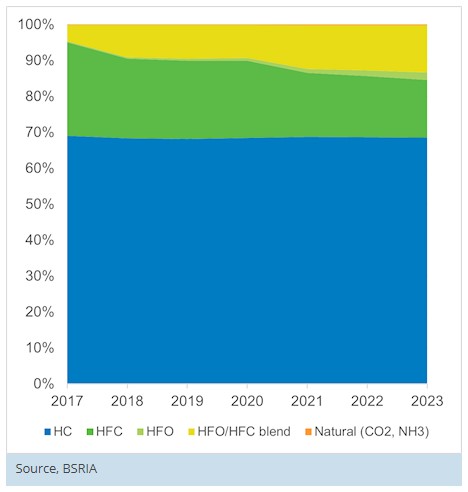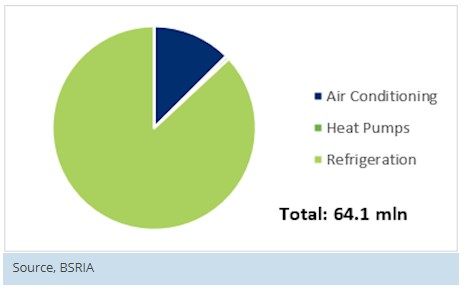EMEA compressor market 2020 - 2023

|
| Penetration of refrigerants by type, % of units, 2017 - 2023. |
Contents |
[edit] Introduction
In March 2021, BSRIA plans to publish a study on compressors used in three key applications: air conditioning (or comfort cooling), heat pumps for space and water heating and refrigeration. The study provides insight into changes in technologies and refrigerants. (This includes stationary applications only.)
[edit] Expanding markets
With the rapid growth taking place in the residential AC market in EMEA (Europe, the Middle East and Africa), sales of rotary compressors are expected to surge. In addition, more suppliers of domestic AC products have set up manufacturing in Europe and the Middle East to encourage proximity with their distributors. This will strengthen the market base for both rotary and scroll compressors used in AC units.
While recent years have seen demand for smaller capacity units in EU countries, sales of splits and other AC units in the commercial sector are expected to falter, as high-street retailers suffer from the double blow of COVID-19 and the growth of e-commerce, which is set to continue.
Above a certain threshold of 250-300 kW, screw compressors are largely used in chillers. Centrifugal oil-free compressors compete with screw but their use is more limited, due to their cost premium.

|
| HAC&R compressors by application, by volume (million units), 2020. |
[edit] Heat pumps
Despite the impact of COVID-19 and the lockdown imposed in EMEA countries, the heat pump market in 2020 held up remarkably well and registered growth. Heat pumps are surfing on a wave of legislation and other drivers for the decarbonisation of buildings, in particular of heating systems.
For those heat pumps that are entirely manufactured in EMEA, this encourages the market for rotary compressors in capacities up to 10 kW and scroll compressors in the range above. Screw compressors are also used in units sold for large industrial applications including district heating, starting at about 200 kW capacity and reaching above 2 MW.

|
| Sales vs production of HAC&R compressors by type, by volume (units), 2020 and 2023. |
The refrigeration sector is a key market for compressors in EMEA, as there are several very important suppliers of refrigeration units operating in the region. It accounts for a significant share of compressors, in particular for reciprocating types. In the long run, scroll compressors are not expected to take market share from semi-hermetic reciprocating, as they are not able to handle the same breadth of applications and refrigerant types.
[edit] Refrigeration
The refrigeration sector is going towards a general reduction of energy required for food conservation. Energy saving has been pushed by legislation in several countries, in particular the European Union, where directives such as Ecodesign and Ecolabel, which are under revision, have driven the uptake of electronic speed variation in compressor motors.
In EMEA, refrigerants are following the general trend of a shift towards alternatives with lower global warming potential, and the European Union is at the forefront of this move. While the AC industry is operating the move towards R32, which is a stopgap rather than a long-term solution, other refrigerants for large compressors operating at lower pressure include pure HFO such as R1234ze. CO2 or hydrocarbons such as propane (R290) remain limited to specific products and climates.
While the majority of the domestic HP market is still using R410A, there are more initiatives towards using propane in outdoor units for HP than in AC. In addition, the use of R1234ze in large screw units, with its large temperature range, allows for a growth in the market for commercial heat pumps.
Finally, while the domestic refrigeration market is dominated by isobutane (R600a), in commercial applications the use of R404A faltered when HFO/HFC blends became available. While CO2 has become widespread in compressor racks for supermarkets (and propane in plug-in refrigerated display cases), it is expected that HFO blends with low GWP will benefit from the phase out of R404A.
This article originally appeared on the BSRIA website with the headline, 'EMEA Compressor market set to recover in line with OEM markets despite COVID-19 setback'. It was published in February 2021.
--BSRIA
[edit] Related articles on Designing Buildings Wiki
Featured articles and news
RTPI leader to become new CIOB Chief Executive Officer
Dr Victoria Hills MRTPI, FICE to take over after Caroline Gumble’s departure.
Social and affordable housing, a long term plan for delivery
The “Delivering a Decade of Renewal for Social and Affordable Housing” strategy sets out future path.
A change to adoptive architecture
Effects of global weather warming on architectural detailing, material choice and human interaction.
The proposed publicly owned and backed subsidiary of Homes England, to facilitate new homes.
How big is the problem and what can we do to mitigate the effects?
Overheating guidance and tools for building designers
A number of cool guides to help with the heat.
The UK's Modern Industrial Strategy: A 10 year plan
Previous consultation criticism, current key elements and general support with some persisting reservations.
Building Safety Regulator reforms
New roles, new staff and a new fast track service pave the way for a single construction regulator.
Architectural Technologist CPDs and Communications
CIAT CPD… and how you can do it!
Cooling centres and cool spaces
Managing extreme heat in cities by directing the public to places for heat stress relief and water sources.
Winter gardens: A brief history and warm variations
Extending the season with glass in different forms and terms.
Restoring Great Yarmouth's Winter Gardens
Transforming one of the least sustainable constructions imaginable.
Construction Skills Mission Board launch sector drive
Newly formed government and industry collaboration set strategy for recruiting an additional 100,000 construction workers a year.
New Architects Code comes into effect in September 2025
ARB Architects Code of Conduct and Practice available with ongoing consultation regarding guidance.
Welsh Skills Body (Medr) launches ambitious plan
The new skills body brings together funding and regulation of tertiary education and research for the devolved nation.
Paul Gandy FCIOB announced as next CIOB President
Former Tilbury Douglas CEO takes helm.
UK Infrastructure: A 10 Year Strategy. In brief with reactions
With the National Infrastructure and Service Transformation Authority (NISTA).























